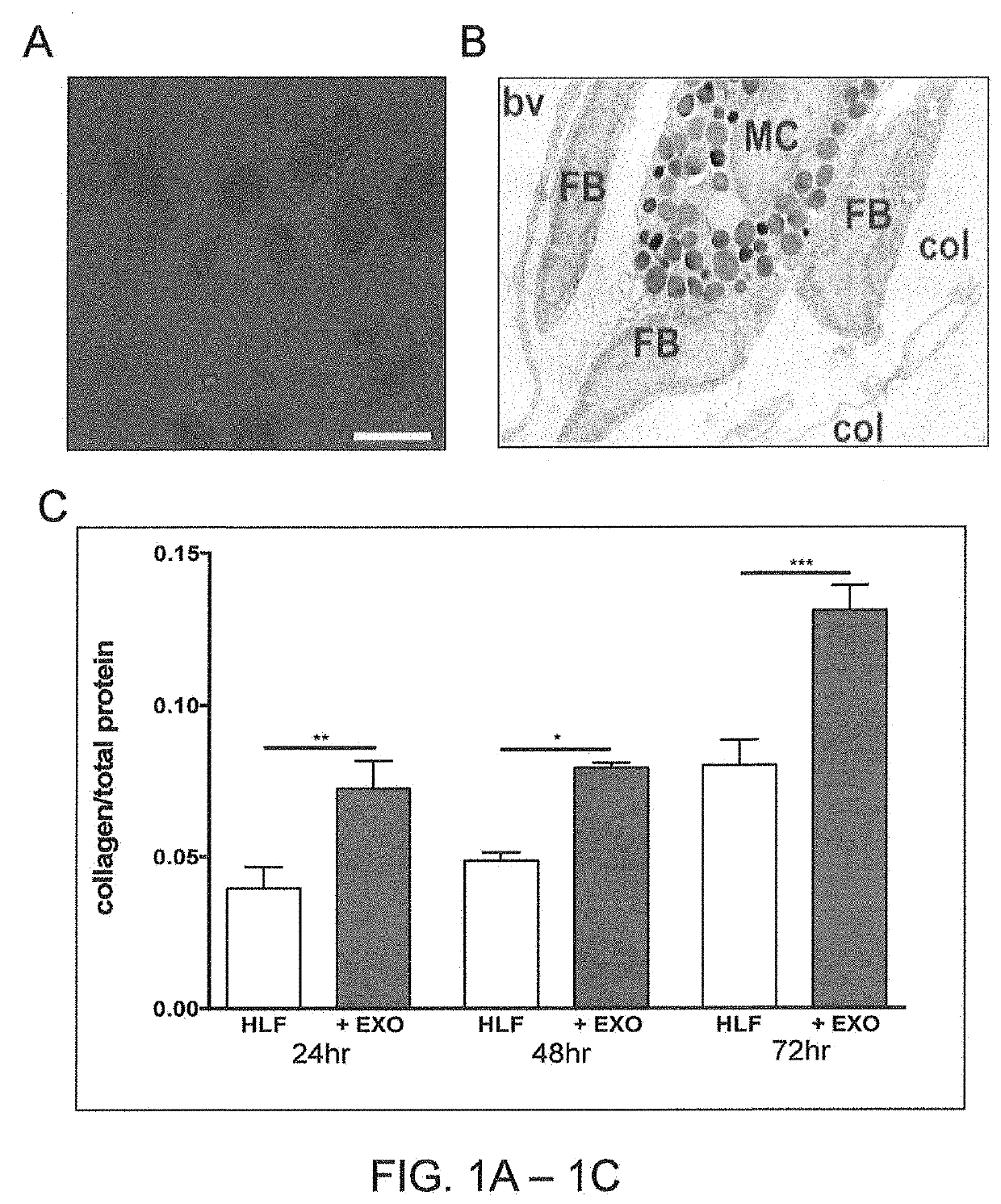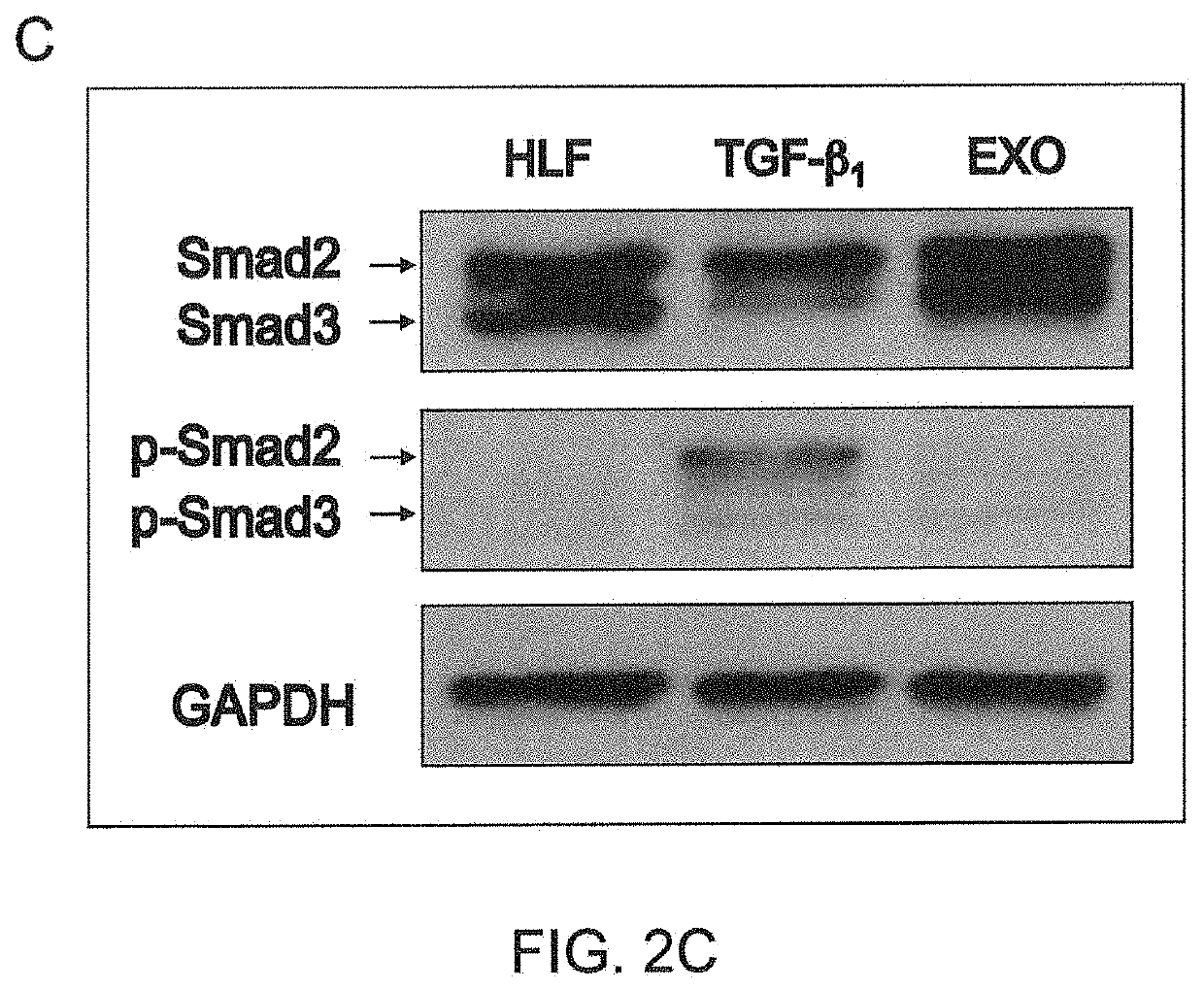Prevention and treatment of organ fibrosis
a technology for organ fibrosis and treatment, applied in the direction of heterocyclic compound active ingredients, organic active ingredients, drug compositions, etc., can solve the problems of poorly treated conditions and limited treatment options
- Summary
- Abstract
- Description
- Claims
- Application Information
AI Technical Summary
Benefits of technology
Problems solved by technology
Method used
Image
Examples
example 1
Exosomes Taken Up by Lung Fibroblasts Stimulate Collagen Synthesis and Secretion: A Novel Means of Fibroblast Activation
[0140]Fibroblasts and mast cells are found in close proximity in tissue (FIG. 1B). Mast cells shed particles, exosomes, that range in size from 20-100 nm and contain RNA and protein. The analysis of mast cell exosome protein content by mass spectrophotometry reveals that mast cell exosomes contain proteins like annexin 2 and the β-subunit of c-P4H, involved with fibrogenesis. Fibroblasts incubated with mast cell exosomes internalize the exosomes as shown in FIG. 1A. The representative micrograph of superimposed transmitted and fluorescent light images (FIG. 1A) shows that mast cell exosomes (green dots) are internalized by the fibroblasts (transmitted light). Following internalization, the exosomes activate the fibroblasts to secrete newly formed collagen (FIG. 1C). Activation occurred as early as 24 h (P<0.01) and continued to stimulate human lung fibroblast colla...
example 2
n of Lung Fibroblasts by Mast Cell Exosomes and TGF-β is Additive Via Different Pathways
[0141]Exosomal activation of human lung fibroblasts was compared to the classical TGF-β1 stimulation of human lung fibroblasts. TGF-β1 stimulation of human lung fibroblasts collagen secretion follows a different time course from the exosome-induced collagen secretion, with a 48 h time lag. Exogenous addition of TGF-β1 caused significant collagen secretion by human lung fibroblasts at the 72 h time point (P<0.05) (FIG. 2A versus FIG. 1B).
[0142]Incubating the human lung fibroblasts with exosomes and TGF-β1 is additive with collagen secretion being significantly greater in human lung fibroblasts exposed to both exosomes and TGF-β1 compared to TGF-β1 alone (P<0.05) or exosomes alone (P<0.01), respectively (FIG. 2B).
[0143]To determine if TGF-β1 and exosomes utilize the same signaling pathway for stimulating human lung fibroblasts collagen secretion, western blotting was performed on human lung fibrobl...
example 3
nzyme Inhibitors Block Human Lung Fibroblast Activity: Collagen Synthesis and Secretion, Proliferation and Migration
[0145]Because both the HIF PHD and c-P4H enzymes are structurally similar and belong to the 2-oxoglutarate (2-OG)-dependent dioxygenases superfamily, it was reasoned that HIF PHD antagonists that function as analogs of 2-OG, a cofactor that accepts one oxygen from molecular dioxygen to become succinate as the second oxygen forms trans-4-hydroxyproline, can also block c-P4H enzymatic activity. C-P4H is necessary for the assembly of newly formed collagen.
[0146]RXD and Collagen Secretion: In vitro experiments with human lung fibroblasts show that RXD inhibits collagen secretion in untreated fibroblasts, fibroblasts co-cultured with mast cell exosomes, and fibroblasts exposed to exogenous TGF-β1, the classic inductor of collagen synthesis. (FIG. 3A). All values presented are normalized for total protein.
[0147]RX and Fibroblast Proliferation: The data in FIG. 3B-3D show tha...
PUM
| Property | Measurement | Unit |
|---|---|---|
| time | aaaaa | aaaaa |
| time | aaaaa | aaaaa |
| time | aaaaa | aaaaa |
Abstract
Description
Claims
Application Information
 Login to View More
Login to View More - R&D
- Intellectual Property
- Life Sciences
- Materials
- Tech Scout
- Unparalleled Data Quality
- Higher Quality Content
- 60% Fewer Hallucinations
Browse by: Latest US Patents, China's latest patents, Technical Efficacy Thesaurus, Application Domain, Technology Topic, Popular Technical Reports.
© 2025 PatSnap. All rights reserved.Legal|Privacy policy|Modern Slavery Act Transparency Statement|Sitemap|About US| Contact US: help@patsnap.com



